
Return to Gallery
Display Contents
Thanet Reach Business Park
Flint blades
Burins and microburins
Saw blade
Scales in centimetre divisions
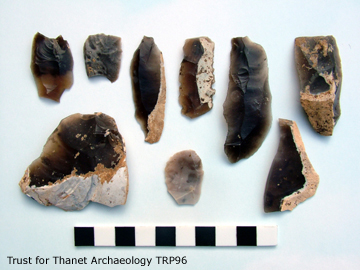
The following
pictures show flintsThanet Reach Business Park
It is most likely that
these features date to the
Mesolithic and as such would be the first known examples to be
excavated in Thanet.
In all, five
related features were discovered. They comprised a pit and four
stake-holes. The pit produced all the illustrated finds.
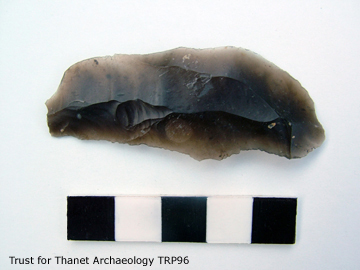
The production of flint
blades, such as the examples
above and
below, played an important part in our Mesolithic ancestors’
tool-making survival
strategy.
There was no evidence for
the use of pottery, which is
exactly what one would expect. The Mesolithic period is ‘aceramic’ - existing before the invention of
pottery vessels.
Instead our ancestors would
have fashioned vessels from
wood, leather and other organic materials. Artefacts like these will
only survive down to our time in exceptional
circumstances. That is usually when they are preserved in waterlogged
and anaerobic conditions which inhibit bacterial growth and decay.
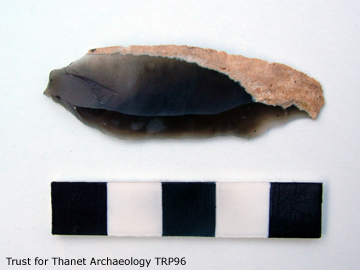
Wooden stakes, driven into the ground, may have formed a frame which could have been woven with smaller branches and roofed with leaves or possibly animal hide.
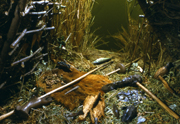
Reconstruction of a hunter-gatherer's shelter
Copyright Museum of London
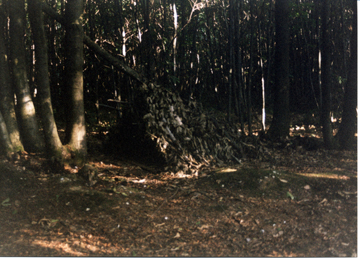
This could have
provided a temporary shelter for our flint-knappers,
perhaps while on a hunting expedition.
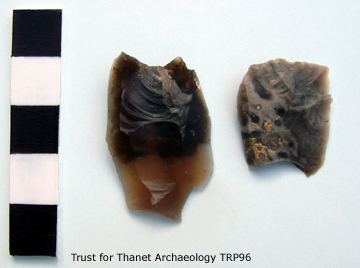
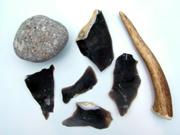
Flint knapping kit

Flake characteristics
Adapted from a drawing
by Len Jay
The
two
flints shown above and below are similar to
types known as burins and microburins. Burins are gouging/engraving
tools most commonly found in Upper Palaeolithic, Mesolithic and
Early Neolithic flint industries.
Microburins are waste products distinctive of
a Mesolithic flintworking technology.
Microburins are associated
with the forming of small
Mesolithic
blade-tools known as microliths. They
comprise the thicker (proximal) end of a much longer blade-flake. It is
the proximal end which received the hammer-blow that struck the
original flake
from the flint core.
This end of a struck flake
contains the 'striking platform' and
the 'bulb of percussion'. The bulb is a swelling on the inner surface
of the flake which results from the impact of the hammer.
The microburin technique
normally employs some preparetry work
before removing the
proximal end of a blade-flake. This involves finely chipping a
small notch into one side of the blade which dictates
the point of the break. It is the
lower portion of the blade that is removed to make a tool.
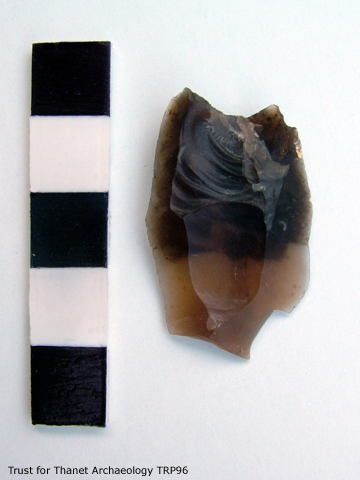
The proximal flake
pictured
above looks like a microburin and has the
appearance of a true burin tool.
The burin facet is a narrow
cutting edge which can be seen on the right-hand side of the flake.
Such a tool could be used for cutting small
slots in wood, antler or bone to create tools and handles/hafts. It
could also be used also for engraving decoration/artwork.
The
potential working edge of this piece is unused, however. As such this
flake could be a microburin, created by snapping the blade-flake
directly without employing any retouch.
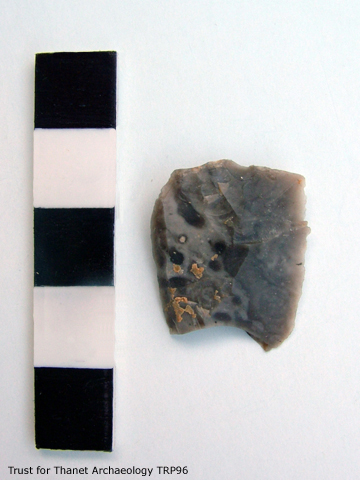
The other
example shown
above also has the appearance of a microburin, but is not of classical
form (and may not be one at all).
The bottom (distal) end of
this flake has been snapped directly.
However, the shape of the flake suggests that the original piece might
not have been much longer in the first place and this breakage may be
accidental.
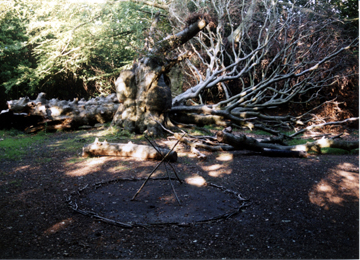

The Thanet Reach area at Westwood today
As suggested
by the name of
‘Westwood’, this area was
once covered with trees until fairly recent times.
It may stretch the
imagination a bit for those who know the area now, but try and envisage
the wildwood environment that met our hunter-gatherer and early farmer
ancestors here.
Imagine the view as they sat and made tools like this saw blade below, creating and discarding the microburin in the process.
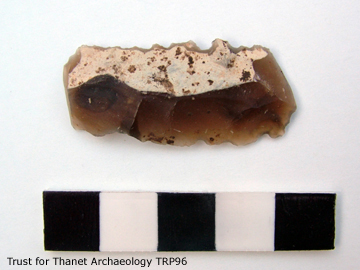
Several such pieces could have been set in series together within a handle to create a larger composite tool capable of small wood, antler or bone-working tasks. The working of both sides of this tool suggests that the segment may have been re-worked and re-set within its haft once one side had become worn.

A hunter-gatherer base-camp
Copyright unknown
In his report
on this site, Thanet Trust's former Director Dave
Perkins noted that all the potential Mesolithic features were filled
with a fine white loess soil which was quite unlike that which filled
all the later features.
This type of soil now
rarely survives on Thanet, being
eroded and recycled through the years. An exposure at Pegwell Bay has
been dated to circa 4170 BC
(+/- 250 years), based on the carbon-dating of
the plants which colonised it (Weir, Catt and
Madgett 1971). Dr. Perkins notes that this
doesn’t help in actually dating our features
themselves, but could indicate a date before which they should
have been
constructed.
Perkins D.R.J. 1996. Thanet Reach Business Park. Trust for Thanet Archaeology report.
Perkins D.R.J. 1997. Thanet Reach Business Park site, St. Peter's, Broadstairs. Archaeologia Cantiana CXVII, p229.
Weir A.H., Catt J.A. and Madgett P.A. 1971. Periglacial soil formation in the loess at Pegwell Bay, Kent. Geoderma 5.
Version 1 - Posted 07.04.06
Version 2 - Posted 21.10.06
All
content © Trust for Thanet Archaeology